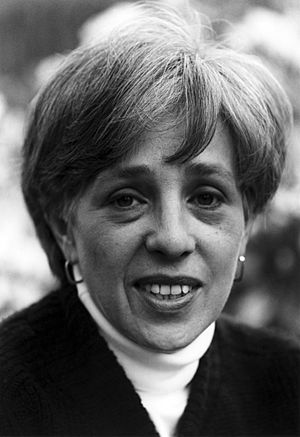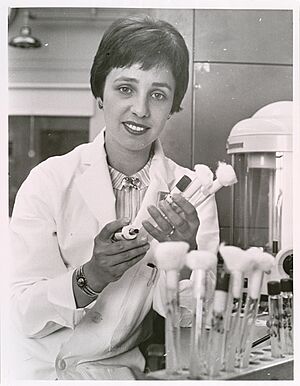Maxine Singer facts for kids
Quick facts for kids
Maxine Singer
|
|
|---|---|
 |
|
| Born |
Maxine Frank
February 15, 1931 New York City, New York, U.S.
|
| Died | July 9, 2024 (aged 93) Washington, D.C., U.S.
|
| Nationality | American |
| Alma mater | Swarthmore College (A.B.) Yale University (Ph.D) |
| Known for | Recombinant DNA techniques |
| Spouse(s) |
Daniel Singer
(m. 1952) |
| Children | 4; including Amy and Stephanie |
| Awards | AAAS Award for Scientific Freedom and Responsibility (1982) National Medal of Science (1992) Vannevar Bush Award (1999) Public Welfare Medal (2007) ASCB Public Service Award (2008) |
| Scientific career | |
| Fields | Molecular Biology Biochemistry |
| Doctoral advisor | Joseph Fruton |
Maxine Frank Singer (born Frank; February 15, 1931 – July 9, 2024) was an American scientist. She was a molecular biologist, meaning she studied the tiny parts of living things like DNA. She also worked as a science leader, helping to guide important research.
Maxine Singer was famous for several things. She helped figure out the genetic code, which is like the instruction manual for all living things. She also played a big part in discussions about recombinant DNA. This is a way to move genes from one living thing to another. She helped create rules to make sure this new science was used safely. Later, she led the Carnegie Institution of Washington, a famous science organization.
In 2002, Discover magazine named her one of the 50 most important women in science.
Contents
Early Life and Learning
Maxine Frank was born in New York City on February 15, 1931. Her parents were Henrietta and Hyman Singer. Her father was a lawyer, and her mother stayed home to care for the family.
After finishing Midwood High School in Brooklyn, Maxine went to Swarthmore College. There, she studied chemistry and a bit of biology. She then continued her studies at Yale University. In 1957, she earned her Ph.D. (a high-level degree). Her research at Yale focused on understanding protein chemistry.
A Career in Science
After getting her Ph.D., Maxine Singer joined a lab at the National Institutes of Health. This is a big research center in the U.S. She began to focus on nucleic acids, which are important molecules like DNA and RNA.
From 1980 to 1987, she led different research teams. These teams studied biochemistry at the National Cancer Institute.
Understanding Genes and DNA
Maxine Singer made big discoveries in biochemistry and molecular biology. She worked with another scientist, Leon Heppel. They studied special proteins called enzymes that help make nucleic acids. Their work helped other scientists, like Marshall Warren Nirenberg, figure out the genetic code.
The genetic code is how DNA's instructions are read to build proteins. Singer and Heppel studied an enzyme that could create random RNA sequences. RNA is like a messenger molecule that carries instructions from DNA. They used special methods to understand these RNA sequences. This allowed them to create artificial RNA strands. These strands helped Nirenberg match each of the twenty amino acids (the building blocks of proteins) to a specific RNA code.
Singer also studied how chromatin is structured. Chromatin is how DNA is packed inside our cells. She also looked at how viruses swap genetic material. In the 1980s, her research focused on something called LINEs. These are pieces of DNA that can move around in our genes. She found that LINE-1, a type of LINE, can move and insert itself into new places. This movement can sometimes cause changes in nearby genes. These changes can lead to genetic diseases.
Leading the Scientific Community
Besides her research, Maxine Singer helped shape science rules. In 1973, she co-chaired a science meeting. At this meeting, she brought up concerns about a new technology. This technology was recombinant DNA technology. It allowed scientists to combine DNA from different sources.
Because of these concerns, she helped organize the Asilomar Conference on Recombinant DNA in 1975. This was a big meeting where scientists came together. They discussed the possible dangers of recombinant DNA research. Singer suggested that research should continue carefully. She wanted rules and safeguards until more was known about the risks.
Singer also supported women in science. She wrote an article saying that universities should help women who want to study science and engineering. She felt that unfair biases might stop them. She also started a program called "First Light." This program taught science to elementary school students in Washington, D.C. It aimed to make math and science education better.
Maxine Singer wrote over 100 science papers. She also wrote several books with Paul Berg. These books helped people understand molecular genetics. Some of her books include Genes and Genomes (1991) and Dealing with Genes (1993). In 2018, she published Blossoms: And the Genes that Make Them. This book explained why flowers bloom using genetics.
Personal Life
Maxine Frank married Daniel Singer in 1952. Daniel was also a student at Swarthmore College. They had four children together: Ellen, Amy, David, and Stephanie.
Maxine Singer passed away at her home in Washington, D.C. on July 9, 2024. She was 93 years old.
See also
 In Spanish: Maxine Singer para niños
In Spanish: Maxine Singer para niños


